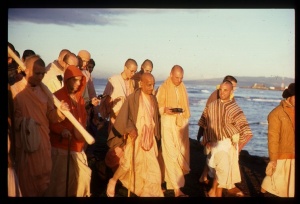CC Madhya 19.61

A.C. Bhaktivedanta Swami Prabhupada
TEXT 61
- se-kāle vallabha-bhaṭṭa rahe āḍāila-grāme
- mahāprabhu āilā śuni’ āila tāṅra sthāne
SYNONYMS
se-kāle — at that time; vallabha-bhaṭṭa — Vallabha Bhaṭṭa; rahe — resided; āḍāila-grāme — in the village known as Āḍāila; mahāprabhu — Śrī Caitanya Mahāprabhu; āilā — has come; śuni’ — hearing; āila — came; tāṅra sthāne — to His place.
TRANSLATION
At that time, Śrī Vallabha Bhaṭṭa was staying at Āḍāila-grāma, and when he heard that Śrī Caitanya Mahāprabhu had arrived, he went to His place to see Him.
PURPORT
Vallabha Bhaṭṭa was a great learned scholar of Vaiṣṇavism. In the beginning he was very much devoted to Śrī Caitanya Mahāprabhu, but since he thought that he could not receive proper respect from Him, he later joined the Viṣṇu Svāmī sect and became the ācārya of that sect. His sect is celebrated as the Vallabhācārya-sampradāya. This sampradāya has had great influence in Vṛndāvana near Gokula and in Bombay. Vallabha Bhaṭṭa wrote many books, including a commentary on Śrīmad-Bhāgavatam called Subodhinī-ṭīkā and notes on the Vedānta-sūtra in the form of an Anubhāṣya. He also wrote a combination of sixteen short works called Ṣoḍaśa-grantha. The village where he was staying—Āḍāila-grāma, or Adelī-grāma—was near the confluence of the rivers Ganges and Yamunā, on the other side of the Yamunā from Prayāga, about one mile from the river. A temple of Lord Viṣṇu there still belongs to the Vallabha-sampradāya.
Vallabha Bhaṭṭa was originally from a place in southern India called Trailaṅga. There is a railway station there called Niḍāḍābhalu. Sixteen miles from that station is a village called Kāṅkaḍabāḍa, or Kākuṅrapāḍhu. A learned brāhmaṇa named Lakṣmaṇa Dīkṣita used to live there, and Vallabha Bhaṭṭa was his son. There are five sections of the brāhmaṇa community of Āndhra Pradesh, known as Bella-nāṭī, Vegī-nāṭī, Muraki-nāṭī, Telagu-nāṭī and Kāśala-nāṭī. Out of these five brahminical communities, Vallabhācārya took his birth in the community of Bella-nāṭī in the year 1400 Śakābda Era (A.D. 1478). According to some people, Vallabha Bhaṭṭācārya’s father took sannyāsa before Vallabha’s birth, and he returned home to take Vallabhācārya as his son. According to the opinion of others, Vallabhācārya was born in 1400 Śakābda Era on the Ekādaśī day of the dark moon in the month of Caitra, and he took his birth in a brāhmaṇa family surnamed Khambhaṁpāṭībāru. According to this account, his father’s name was Lakṣmaṇa Bhaṭṭa Dīkṣita, and he was born in Campakāraṇya. In someone else’s opinion, Vallabhācārya appeared near the village named Cāṅpā-jhāra-grāma, which is near a railway station named Rājima in Madhya Pradesh.
After studying for eleven years at Vārāṇasī, Vallabhācārya returned home. On his return, he heard that his father had departed from the material world. Keeping his brother and mother at home, he went to the banks of the river Tuṅgabhadrā, to a village called Vidyānagara, where he enlightened Kṛṣṇadeva, the grandson of King Bukkarāja. After that, he traveled throughout India thrice on trips lasting six years each. Thus he passed eighteen years and became victorious in his discussions of revealed scripture. When he was thirty years old, he married Mahālakṣmī, who belonged to the same brāhmaṇa community as his. Near Govardhana Hill he established a Deity in the valley. Finally he came to Āḍāila, which is on the other side of the Yamunā from Prayāga.
Vallabhācārya had two sons, Gopīnātha and Viṭhṭhaleśvara, and in his old age he accepted the renounced order. In 1452 Śakābda Era (A.D. 1530), he passed away from the material world at Vārāṇasī. His book known as Ṣoḍaśa-grantha and his commentaries on the Vedānta-sūtra (Anubhāṣya) and Śrīmad-Bhāgavatam (Subodhinī) are very famous. He wrote many other books besides.